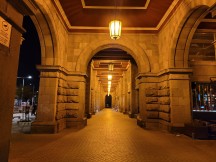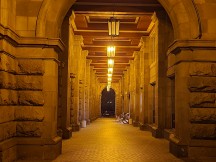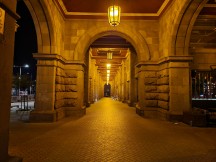Samsung Galaxy Z Fold2 review

Video capture quality
Video capture on the Z Fold2 is capped at 4K. There is no fancy 8K here, and frankly, it won't really be missed. We still think 4K remains the significantly more practical video resolution of choice. The Z Fold2 can record at 4K with all of its cameras, even the 10MP selfies. You can do up to 4K@60fps on the main and telephoto cameras, while the ultrawide can only do 30fps. That's a common limitation with most ultrawides.

As far as the video capture UI is concerned, there are absolutely no oddities to note. Samsung has, once again, managed to stick to its familiar look and feel and disguise any particular tweaks, particularly implemented to cater to the foldable form factor. Options are pretty standard for a flagship Samsung as well and include optional HDR10+ recording, Zoom-in mic, and an HEVC toggle.
If you leave the latter alone, the Z Fold2 encodes all of its videos in h.264, with an AVC video stream and an accompanying stereo AAC one at 48 kHz. All perfectly normal and pretty much the norm. There are no bitrate irregularities either. From a purely technical standpoint, everything is operating, as the engineers like to say - "nominally".
We kick things off with some samples at full resolution and 30fps, for the best possible quality. There isn't a lot to note here. We expected Samsung flagship-level performance going in, and we got exactly that. No surprises.
Plenty of detail, a decently wide dynamic range, basically no noise or other artifacts. Colors tend to, once again, have a bit of that particular Samsung "punchiness". There is really nothing to complain about.
At its maximum 4K@30fps setting and native 2x magnification, the telephoto camera delivers solid flagship-level performance, as well. Sure, there is a bit more noise, but kept well under control. The telephoto camera tends to hunt for focus more than we would like. It's not a major issue, but, when dealing with flagship cameras, you expectations are high.
Of course, these problems naturally worsen as we crank digital zoom to 4x and then 10x. As far as the increasingly-noticeable camera shake is concerned, it was a bit windy outside and our methodology requires capturing theses samples with a tripod and video stabilization off. Flipping the later back on eliminates these kinds of small shakes entirely.
Overall, we would say that despite the mounting quality deterioration with increased zoom, given enough light, the telephoto on the Z Fold2 still produces very usable results.
Footage for the ultrawide camera was in no way disappointing either. Sure, as with any ultrawide, you get more softness, more noise, and a narrower dynamic range. Softness, however, is only noticeable around the edges of the frame and not all that bad. As far as resolved detail goes, there is still plenty to work with. And we especially appreciate Samsung's continued and impressively successful efforts to keep the color profile of its different cameras as similar as possible.
As we mentioned, 60fps recording is available at full 4K resolution on the main and telephoto cameras. If, of course, that is something you fancy.
Dropping the resolution down to FullHD still leaves you with what we would call quite competent results. Other than the expected loss of detail, the overall quality of the video doesn't deteriorate in any major way. That's exactly what you want to see.
The same is mostly true for the telephoto camera, as well, though, at higher zoom levels, things start to deteriorate rather quickly and with that, the utility of zooming into thigs fades away. Here is a playlist with all of our telephoto samples to go through, if you are interested, including 4x and 10x, FullHD samples.
Like we mentioned earlier, the two identical selfie cameras on the Z Fold2 can also capture video at 4K. The fact, however, that you could just use the powerful main cameras to do selfie videos, actually makes the Z Fold2 a powerful vlogging device. At least one paper, that is, since in practice, you either have to hold the device open with your hand extended out, which gets uncomfortable fast, or you have to engineer some special rig or selfies-stick mounting solution to accommodate an open Z Fold2. Neither is a particularly elegant decision. Keeping that in mind, the quality of the video the selfie cameras produce is not totally irrelevant.
We have very little to complain about here, as well. The detail is plenty, colors look great. The only real issue that we noticed with dynamic light sources is that the 10MP sensor is starting to show its limited dynamic range on occasion. Again, however, this is kind of us nitpicking more than actual complaints.
The Z Fold2 is no slouch when it comes to Video stabilization. On top of OIS on the main camera, there is EIS for every one of the snappers. It is enabled by default and can be disabled from a toggle in the camera settings.
EIS in itself does a very decent job of smoothing-out small shakes and bumps and will likely be more than enough for regular use. It crops away some of the frame, but, other than that, can work at the full resolution of any of the Z Fold2's cameras.
This includes the two 10MP selfies cameras, as well. Results are impressive and comparable all-around.
As you can already tell by these videos, beyond basic EIS, the Z Fold2 also has Samsung's famous Super Steady mode. It pulls out all of the stops when it comes to stabilization and is best applied to things like sports. You can see it here working its magic while sprinting.
Super Steady is limited to the ultrawide and the main cameras on the Z Fold2, although, that is a bit hard to tell since so much is getting cut-away from the frame. Still, we are going by the tree iconography here, which suggests that the telephoto only gets the basic EIS stabilization.
Before we wrap-up the camera section, Samsung's Pro Video mode deserves some recognition. It is quite comprehensive and includes things like different focus modes, as well as manual focus, complete with focus peaking. Also, a nifty histogram and audio level meters.
The latter is particularly handy, since there is an audio input option that can tune the on-board microphones for front-, back- or omni-directional capture and also take audio from either a Bluetooth or a USB source. That's pretty awesome. Of course, you get manual control over white balance, ISO and aperture.
Rounding-off the video section, we took some sample clips, at 4K, of our standard test posters. We made sure to do that with both the main camera and the telephoto.



Samsung Galaxy Z Fold2 against the Samsung Galaxy Note20 Ultra and the Samsung Galaxy Fold in our Video compare tool



Telephoto: Samsung Galaxy Z Fold2 against the Samsung Galaxy S10 and the Sony Xperia 1 II in our Video compare tool
It is worth noting that for particularly dark zoom shots, the Z Fold2 automatically switches over from the telephoto camera to a crop of the main one. This is perfectly standard behavior and usually beneficial to the user. We are just pointing it out.
Low-light camera quality
Samsung has one of the better low-light implementations around. Just like the rest of its camera science, "mature" would be a good way of describing it. Especially when working on top of capable hardware. Which is generally the case with the Z Fold2.
Looking at shots from the main 12MP camera in full Auto mode (AI and HDR on Auto), we see that there is plenty of detail, considering the conditions. Sharpness is good, without any obvious signs of aggressive software over-sharpening. Noise is kept at bay well, too.






Main 12MP camera low-light samples
Overall, another expectedly solid flagship showing. After all, anything different would have been an unexpected surprise, since we have already seen this particular camera prove its salt in the Galaxy S20.
Moving on to the telephoto camera at its native 2x zoom level, we definitely get a bit more noise all-around the frame. Also, the occasional focus-hunting issue we experienced with this camera in good lighting conditions is even worse when the lights go down. Again, it's just a case of occasionally losing focus and then taking a few seconds to re-focus. If you are patient enough, it almost always gets it right. So, not a major dealbreaker.






Telephoto 12MP camera low-light samples
Sharpening artifacts, like the occasional overly-emphasized straight lines are a bit more common here, compared to the main camera, as well. Again, however, this is us nitpicking more than anything else. The overall quality of the low-light zoom shots the telephoto camera produces is solid. You get plenty of detail and surprisingly well-balanced exposure and handling of light sources.
The only camera out of the main trio on the back that fails to perform at true flagship levels is the ultrawide one. It tends to deliver pretty dark and soft shots. That being said, these are still far from the worst we have seen from an ultrawide. Most are usable, whereas plenty of phones still spit-out throwaway still in similar conditions.






Ultrawide 12MP camera low-light samples
Enter Night mode. Not only is it available on the Z Fold2, but you can freely use it on any of its cameras. It is the standard Samsung implementation, which, again, is not criticism. On the contrary, Samsung has one of the more snappy Night mode implementations out there. The algorithm does a great job of automatically adjusting its exposure time - lowering or raising it as it deems fit.
It varies depending on available light and also from camera to camera, with generally lower values for the most-potent main snapper and higher ones for the other cameras. The timer rarely goes above 5 seconds, though, which is a reasonable amount to hold still, even if you are holding the hefty Z Fold2 fully open for selfies with the main cameras. Plus, the stacking algorithm itself is quite forgiving towards small shakes and twitches while capturing.






Ultrawide 12MP camera Night mode samples
Night mode is almost guaranteed to make your low-light photos better. Even if you accidentally leave it on while ambient light is still not low enough, Samsung's software is smart enough to just skip the extra stacking feature, so as not to ruin the shot. Of course, the worse the typical low-light performance of a camera, the more it stands to gain from a good Night mode implementation. A fact that is clearly obvious by the Night mode shots from the ultrawide.
The difference here is substantial. Sharpness is a lot better across the board. Dark and underexposed areas are brightened more often than not.
Night mode has noticeable effects on telephoto quality too. Circling back to the minor issue we had with the sharpening algorithm, sometimes overly-emphasizing certain straight lines and details on the telephoto camera, we see a lot more of that going on with Night mode on. If you don't pixel-peep, it doesn't look bad at all, even if some of the finer details can end up fabricated by the algorithm, rather than captured by the camera.






Telephoto 12MP camera Night mode samples
Last and probably least, we have Night mode on the main camera. Out of all three, it needs the extra help the least. Thankfully, Samsung's algorithm is well-aware of this fact as well, often setting the extra Night Mode capture and stacking time low or not using it at all.






Main 12MP camera Night mode samples
When Night mode does kick in, shots typically get a bit of extra sharpness. The algorithm tends to be a lot less heavy-handed here than with telephoto shots, leaving us little to complain about.
Selfies with any of the two 10MP selfie cameras tend to gain a lot from Night mode, as well. They manage a decent-enough job on their own too.






Selfie 10MP camera low-light samples




Selfie 10MP camera Night mode samples
Of course, if you aim to get the best possible selfie from the Z Fold2, the proper way to do that is to go into its special main cameras, unfolded selfie mode. Then you can benefit from the prowess of the bigger sensors and brighter lenses.




Low-light selfies with the main cameras
And, for especially tough and dark shots, you can, of course, enable Night mode on top of the special selfie mode, as well. Here are some examples form all three cameras.




Night mode selfies with the main cameras
Having Night mode On in low-light conditions will pretty much always lead to better photos from any of the Z Fold2's cameras. Or, failing that, it will simply automatically turn off, without ever ruining your shots.
Finally, here are some low-light test videos. These were captured in the regular video mode on full auto with the trio of main cameras on the Z Fold2. You could potentially squeeze-out slightly better results using the versatile Pro Video mode, but you definitely have to know what you are doing.
For most users, regular video mode on auto will produce more than adequate results. Definitely ones that we would consider flagship-grade.
Reader comments
- Samsung galaxy fold
- 18 Feb 2024
- UD%
Samsung galaxy fold 2
- Adit garg
- 02 Jun 2022
- vGc
Hi I have fold 2 phone , this phone is ever worst phone I bought this mobile 15 days ago and it's screen is showing bubbles neither this phone has fallen nor damaged..but customer care stated to not take it back without paying money I was switch...
- MrSupercar55
- 18 May 2022
- MAg
Careful what you wish for, Einstein. You might just get it. You wished for the ability to use an S Pen on a Z Fold. Now the Z Fold 3 is here with the ability to do just that. It still embodies the disadvantages of every other Z Fold. Hideously expens...













